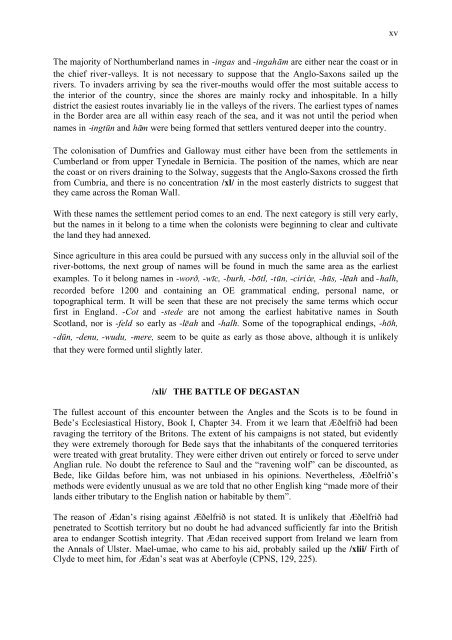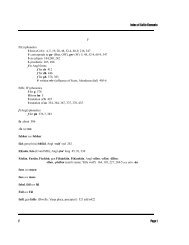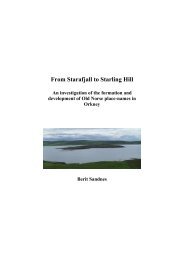May Williamson: The Non-Celtic Place-Names of the Scottish Border ...
May Williamson: The Non-Celtic Place-Names of the Scottish Border ...
May Williamson: The Non-Celtic Place-Names of the Scottish Border ...
Create successful ePaper yourself
Turn your PDF publications into a flip-book with our unique Google optimized e-Paper software.
xv<br />
<strong>The</strong> majority <strong>of</strong> Northumberland names in -ingas and -ingahm are ei<strong>the</strong>r near <strong>the</strong> coast or in<br />
<strong>the</strong> chief river-valleys. It is not necessary to suppose that <strong>the</strong> Anglo-Saxons sailed up <strong>the</strong><br />
rivers. To invaders arriving by sea <strong>the</strong> river-mouths would <strong>of</strong>fer <strong>the</strong> most suitable access to<br />
<strong>the</strong> interior <strong>of</strong> <strong>the</strong> country, since <strong>the</strong> shores are mainly rocky and inhospitable. In a hilly<br />
district <strong>the</strong> easiest routes invariably lie in <strong>the</strong> valleys <strong>of</strong> <strong>the</strong> rivers. <strong>The</strong> earliest types <strong>of</strong> names<br />
in <strong>the</strong> <strong>Border</strong> area are all within easy reach <strong>of</strong> <strong>the</strong> sea, and it was not until <strong>the</strong> period when<br />
names in -ingtn and hm were being formed that settlers ventured deeper into <strong>the</strong> country.<br />
<strong>The</strong> colonisation <strong>of</strong> Dumfries and Galloway must ei<strong>the</strong>r have been from <strong>the</strong> settlements in<br />
Cumberland or from upper Tynedale in Bernicia. <strong>The</strong> position <strong>of</strong> <strong>the</strong> names, which are near<br />
<strong>the</strong> coast or on rivers draining to <strong>the</strong> Solway, suggests that <strong>the</strong> Anglo-Saxons crossed <strong>the</strong> firth<br />
from Cumbria, and <strong>the</strong>re is no concentration /xl/ in <strong>the</strong> most easterly districts to suggest that<br />
<strong>the</strong>y came across <strong>the</strong> Roman Wall.<br />
With <strong>the</strong>se names <strong>the</strong> settlement period comes to an end. <strong>The</strong> next category is still very early,<br />
but <strong>the</strong> names in it belong to a time when <strong>the</strong> colonists were beginning to clear and cultivate<br />
<strong>the</strong> land <strong>the</strong>y had annexed.<br />
Since agriculture in this area could be pursued with any success only in <strong>the</strong> alluvial soil <strong>of</strong> <strong>the</strong><br />
river-bottoms, <strong>the</strong> next group <strong>of</strong> names will be found in much <strong>the</strong> same area as <strong>the</strong> earliest<br />
examples. To it belong names in -worð, -wc, -burh, -btl, -tn, -cirie, -hs, -lah and -halh,<br />
recorded before 1200 and containing an OE grammatical ending, personal name, or<br />
topographical term. It will be seen that <strong>the</strong>se are not precisely <strong>the</strong> same terms which occur<br />
first in England. -Cot and -stede are not among <strong>the</strong> earliest habitative names in South<br />
Scotland, nor is -feld so early as -lah and -halh. Some <strong>of</strong> <strong>the</strong> topographical endings, -hh,<br />
-dn, -denu, -wudu, -mere, seem to be quite as early as those above, although it is unlikely<br />
that <strong>the</strong>y were formed until slightly later.<br />
/xli/ THE BATTLE OF DEGASTAN<br />
<strong>The</strong> fullest account <strong>of</strong> this encounter between <strong>the</strong> Angles and <strong>the</strong> Scots is to be found in<br />
Bede’s Ecclesiastical History, Book I, Chapter 34. From it we learn that Æðelfrið had been<br />
ravaging <strong>the</strong> territory <strong>of</strong> <strong>the</strong> Britons. <strong>The</strong> extent <strong>of</strong> his campaigns is not stated, but evidently<br />
<strong>the</strong>y were extremely thorough for Bede says that <strong>the</strong> inhabitants <strong>of</strong> <strong>the</strong> conquered territories<br />
were treated with great brutality. <strong>The</strong>y were ei<strong>the</strong>r driven out entirely or forced to serve under<br />
Anglian rule. No doubt <strong>the</strong> reference to Saul and <strong>the</strong> “ravening wolf” can be discounted, as<br />
Bede, like Gildas before him, was not unbiased in his opinions. Never<strong>the</strong>less, Æðelfrið’s<br />
methods were evidently unusual as we are told that no o<strong>the</strong>r English king “made more <strong>of</strong> <strong>the</strong>ir<br />
lands ei<strong>the</strong>r tributary to <strong>the</strong> English nation or habitable by <strong>the</strong>m”.<br />
<strong>The</strong> reason <strong>of</strong> Ædan’s rising against Æðelfrið is not stated. It is unlikely that Æðelfrið had<br />
penetrated to <strong>Scottish</strong> territory but no doubt he had advanced sufficiently far into <strong>the</strong> British<br />
area to endanger <strong>Scottish</strong> integrity. That Ædan received support from Ireland we learn from<br />
<strong>the</strong> Annals <strong>of</strong> Ulster. Mael-umae, who came to his aid, probably sailed up <strong>the</strong> /xlii/ Firth <strong>of</strong><br />
Clyde to meet him, for Ædan’s seat was at Aberfoyle (CPNS, 129, 225).




